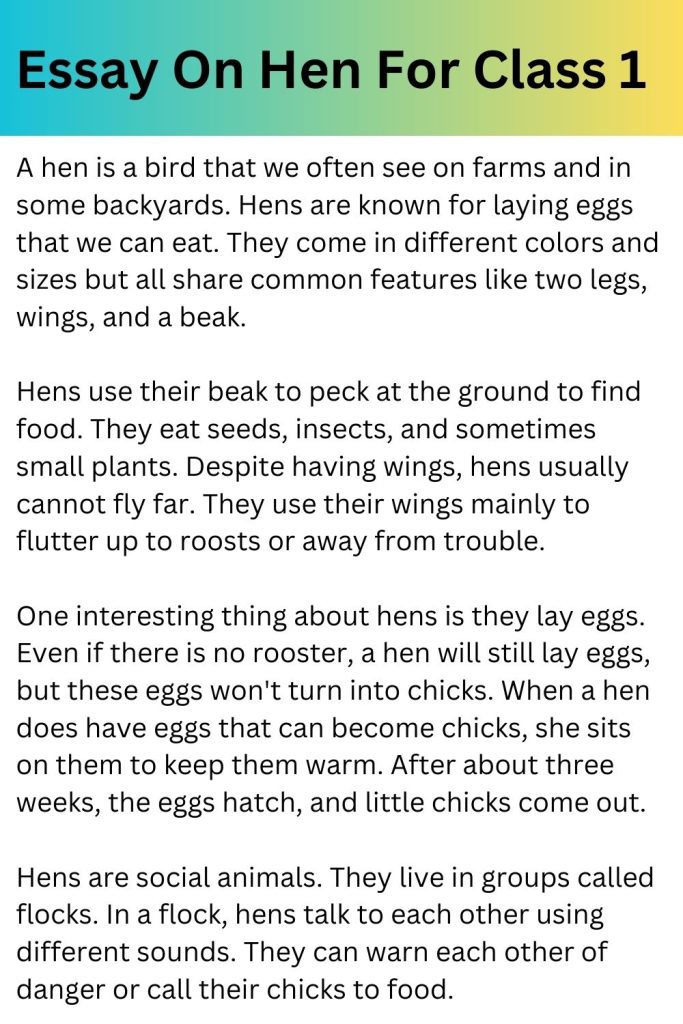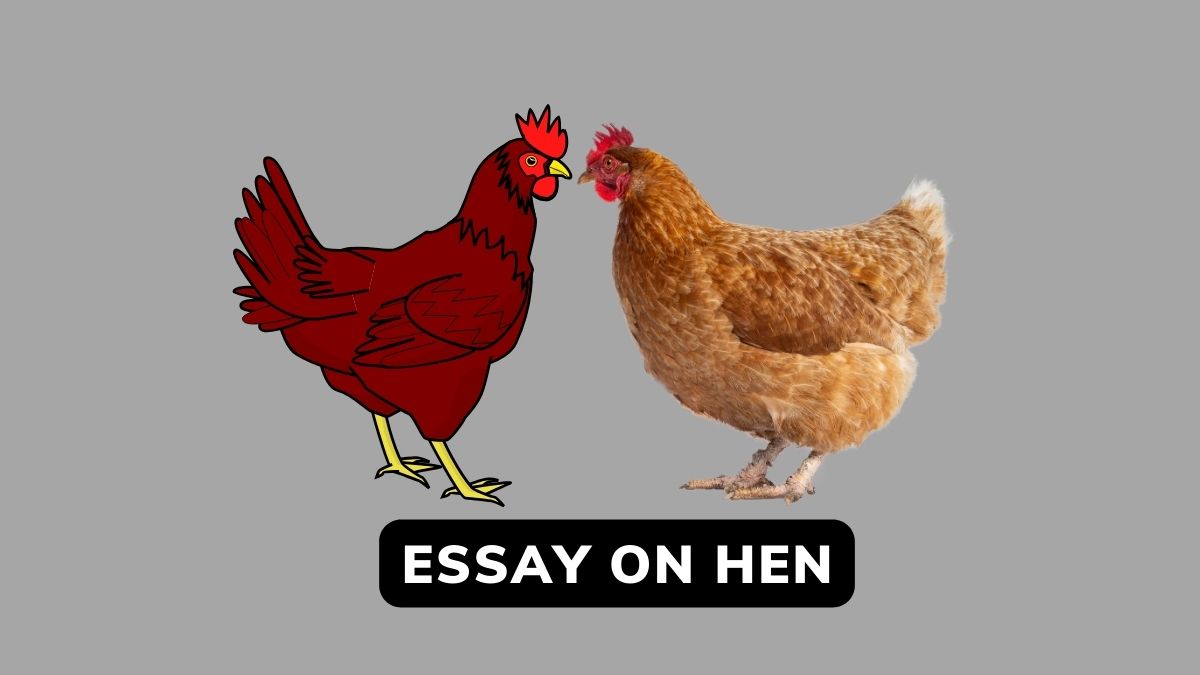Essay On Hen In English For Class 1-5
Essay On Hen For Class 1 – 5
A hen is a bird that we often see on farms and in some backyards. Hens are known for laying eggs that we can eat. They come in different colors and sizes but all share common features like two legs, wings, and a beak.
Hens use their beak to peck at the ground to find food. They eat seeds, insects, and sometimes small plants. Despite having wings, hens usually cannot fly far. They use their wings mainly to flutter up to roosts or away from trouble.
One interesting thing about hens is they lay eggs. Even if there is no rooster, a hen will still lay eggs, but these eggs won’t turn into chicks. When a hen does have eggs that can become chicks, she sits on them to keep them warm. After about three weeks, the eggs hatch, and little chicks come out.
Hens are social animals. They live in groups called flocks. In a flock, hens talk to each other using different sounds. They can warn each other of danger or call their chicks to food.
People keep hens for many reasons. Some people enjoy having them as pets because they can be friendly and have unique personalities. Most often, people keep hens for the eggs they lay. Eggs from hens are a good source of food because they have lots of protein, which is important for our bodies.
In many places around the world, hens are also part of stories and songs, showing how special they are to people. Hens are more than just farm animals; they are a part of our daily lives, giving us food and even being our friends.

Essay On Hen In English
The hen, a common domesticated bird, plays a crucial role in agricultural and household settings worldwide. Esteemed for its ability to provide eggs, a staple in many diets, and meat, the hen is an integral part of human life across cultures. This essay delves into the biology, behavior, and significance of hens, presenting a comprehensive view that enlightens those unfamiliar with these remarkable birds.
Hens belong to the species Gallus gallus domesticus, a subgroup of the red junglefowl from Southeast Asia, which humans domesticated around 8,000 years ago. These birds have been selectively bred over millennia, leading to a variety of breeds with differing characteristics such as size, feather color, and egg-laying capabilities.
Physiologically, hens exhibit several distinctive features. They possess a comb and two wattles, which are fleshy projections on their heads and under their beaks, respectively. These structures play roles in thermoregulation and are also indicators of health and vigor, particularly in roosters, the male counterpart to hens. Hens have a stout build with powerful legs, enabling them to scratch the ground in search of food. Their diet is omnivorous, consisting of seeds, insects, and occasionally small animals, which they forage for throughout the day.
One of the most notable aspects of hen behavior is their egg-laying. A healthy hen can produce over 300 eggs annually, making them invaluable to humans for centuries. The process of laying eggs involves finding a quiet, safe place to nest. Hens show a preference for nesting sites that already contain eggs, a behavior that likely helps in the communal protection of the offspring.
Socially, hens are gregarious creatures that establish a “pecking order,” a hierarchical structure that determines access to food and nesting sites. This social order is essential for the flock’s harmony and efficiency. Hens also exhibit maternal instincts, with the mother hen playing a critical role in brooding and protecting her chicks. She teaches them how to find food and water, demonstrating the complex social behaviors these birds are capable of.
Beyond their biological and behavioral characteristics, hens hold significant cultural and economic roles. They are not only farmed for their eggs and meat but also kept as pets in some cultures, appreciated for their companionship and the simplicity they bring to household gardens. Their presence in folklore and religion across the world underscores their importance in human history and culture.
In summary, the hen is a fascinating creature that offers more than just nutritional value. Through their complex behaviors, social structures, and the diverse roles they play in human societies, hens enrich our lives in myriad ways. Understanding these birds’ biology and lifestyle not only deepens our appreciation for them but also highlights the importance of their conservation and humane treatment in farming practices. As we continue to rely on hens for food and companionship, it becomes imperative to recognize and respect their needs and natural behaviors, ensuring a harmonious coexistence.
5 Lines About Hen In English For Class 1
A hen is a female chicken that lays eggs.
They have soft feathers and a red comb on their head.
Hens can make a clucking sound, especially when they lay eggs.
They eat seeds, insects, and plants.
People keep hens on farms and in backyards for their eggs.







